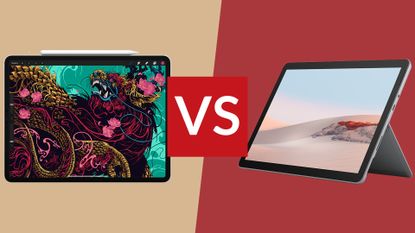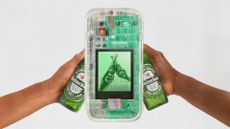Welcome to T3's guide to the Apple iPad Pro (2020) versus the Microsoft Surface Go 2. Here we're pitching two of the best tablets for work against one another.
iPads have come a long way from the days when people complained there were only good for consuming content rather than creating it – and some still make the argument that Windows is better for productivity than iPadOS, largely because you can run desktop apps as well as tablet ones. But you’d need to be a serious Windows fan to argue that Apple’s iPad Pros aren’t heavyweight devices capable of really serious work.
So if you're looking at a lightweight tablet that's also capable of turning into a laptop-type replacement, is the Surface Go or iPad Pro the better option? The Go 2 (or mighty similar and more recent Go 3) certainly starts off much cheaper than the iPad Pro, but there are a lot more factors at play than the cheapest possible price.
iPad Pro vs Surface Go 2: Design and display

While everybody’s having fun redesigning the best laptops and 2-in-1 laptops, these tablets look very similar to each other – that's what happens your device is, basically, just a screen.
Squint and you’ll see that the Surface Go 2 display is a little smaller than the 11-inch iPad Pro: it has a 10.5-inch PixelSense display delivering 1800x1200 pixels at 217ppi. It also has a built-in kickstand.
The iPad Pro has the sharper design overall, all curves and flat sides. It definitely feels like a premium product, helped by the much slimmer bezels than older iPad designs.
The smallest iPad Pro has an 11-inch Liquid Retina display with 2388x1668 pixels at 264ppi. The larger model is 12.9 inches, at 2732x2048 and again a density of 264ppi, making both iPad Pro screens sharper than the pixel regardless of size. Both iPad displays also support the wider P3 colour gamut, plus 120Hz refresh rates (which Apple calls 'ProMotion') and True Tone, which makes them more comfortable to read by adjusting the colour balance for the ambient light.
iPad Pro vs Surface Go 2: Processor and storage
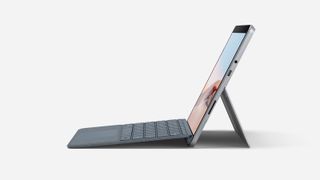
The Surface Go 2 is available with two different processors: an Intel Pentium 4425Y and a dual-core Intel Core M3. The Core M3 version is also available with 4G connectivity as an option. The Pentium version is available with either 4GB RAM and 64GB of eMMC storage, or with 8GB and 128GB of SSD storage. The Core M3 version always comes with 8GB of RAM and 128GB of internal storage.
The iPad Pro comes in two sizes but both have the same eight-core Apple A12Z processor, which isn't configurable at all. Both start with 128GB of internal SSD storage, but can be configured with up to 1TB.
In terms of raw power, it isn't much of a contest here: the iPad Pro scores around 25% higher in Geekbench benchmarks for single-core performance, and nearly 200% higher for multi-core performance. No, that isn't a typo.
iPad Pro vs Surface Go 2: cameras and audio
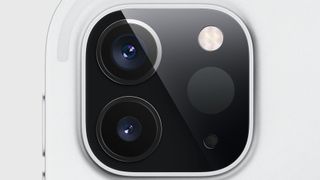
The Surface Go 2 has a 5.0MP front facing camera capable of 1080p Skype video and Windows Hello; the rear camera is 8MP and, again, 1080p for video. There’s a single microphone and twin 2W speakers with Dolby Audio.
Apple’s cameras are much better, with a 12MP wide-angle camera and 10MP ultrawide camera on the rear, capable of 4K video recording at up to 60fps. You have a 7MP TrueDepth camera on the front capable video in 1080p at up to 60fps. The case contains five microphones for clear speech, plus four speakers that do an incredible job of filling the space around you with true stereo sound.
iPad Pro vs Surface Go 2: Software and apps
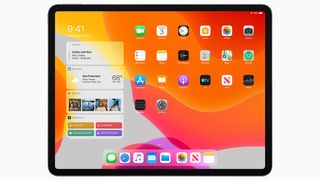
The Surface Go runs Windows 10 Home in S mode by default. That’s the version of Windows that limits app installations to apps from the Microsoft Store, and which requires you to use the Edge browser for safe browsing. You can switch off S mode if you want (unless your IT department won't let you), which means you can then install apps from anywhere like a normal Windows 10 Home PC… but you can’t then turn S mode back on.
The iPad runs iPadOS, and like Windows S Mode you can only run apps from the official App Store, but with any other option.
The Surface Go's strength here is its flexibility – you can stick with apps that have been designed for smaller touchscreens, or just load a desktop app if you really need it.
However, the flip side is that's not the best tablet experience. The Windows store is not overflowing with excellent software – though it certainly has plenty of essentials – and desktop taps are definitely not touch-friendly on a 10-inch screen.
On the iPad, you have the best suite of apps that are actually designed to be used on that size of screen, ranging from common services to some very capable creation tools. The overall experience is much stronger and more cohesive… as long as what you want to do can be done on iPad.
iPad Pro vs Surface Go 2: Connectors, stylus and keyboard

Both tablets can be supplemented with attachable keyboard covers and styluses. For Microsoft that means the Surface Pen and the Surface Go Signature Type Cover, and for the iPad it’s the second-generation Apple Pencil and the Apple Magic Keyboard with its clever cantilever design.
The iPad Pro has a USB-C connector that can be used to connect accessories and storage, plus a special magnetic connector for the Magic Keyboard.
The Surface Go 2 has a USB-C connector and a 3.5mm headphone jack, a Surface Connect port (for custom Surface-ready docks), a Surface Type Cover port and a microSDXC card reader (for expanding the storage).
The iPad Pro has dual-band 802.11ax Wi-Fi 6 HT80 with MIMO and Bluetooth 5.0. Wi-Fi + Cellular models have gigabit LTE.
The Surface Go 2 has 802.11ac Wi-Fi and Bluetooth 4.1. The cellular model supports 4G LTE Advanced.
iPad Pro vs Surface Go 2: Price and verdict

The Pentium version of the Surface Go 2 is £399/$399 for 4GB of RAM and 64GB of storage, rising to £529/$522 for 8GB and 128GB. The Core M3 version is £549/$629 with 8GB and 128GB, or £719/$664 if you want the 4G version.
The 11-inch iPad Pro starts at £769/$799 for 128GB of storage and can be ordered with up to 1TB (£1,269/$1,299). The 12.9-inch model is £969/$999 for 128GB, rising to £1,469/$1,499 for 1TB. Wi-Fi + Cellular models are £150/$150 more.
On the face of it, the Surface Go 2 is a bargain, but there’s a bit more to it than that. The Pentium in the entry-level Go 2 isn’t a match for the standard iPad 10.2-inch, let alone the Pro.
The M3 version is more in line for price with the iPad Air (2020). But the M3 is a dual-core processor and the iPad Air has a six-core CPU; in benchmarks, the A14 Bionic show itself to be more like the iPad Pro for performance, putting it well beyond the Surface Go's power.
The Surface Go 2 is a very good Windows tablet, but the iPad Pro is better in every specification that counts: it’s much faster, it has a better screen, it has better cameras, it has better microphones, it has better speakers, and it has better Wi-Fi. It’s considerably more expensive than the Surface Go 2, but there’s no doubt where the money is going. The iPad Pro isn’t just in a different price bracket. It’s in a different league.
A closer match for the iPad Pro is the Microsoft Surface Pro 7, which is similarly expensive. The Surface Go 2 is a really good machine, but the overall experience of the iPad Pro comfortably beats it, unless you really need to be able to run Windows software on a cheaper tablet.
